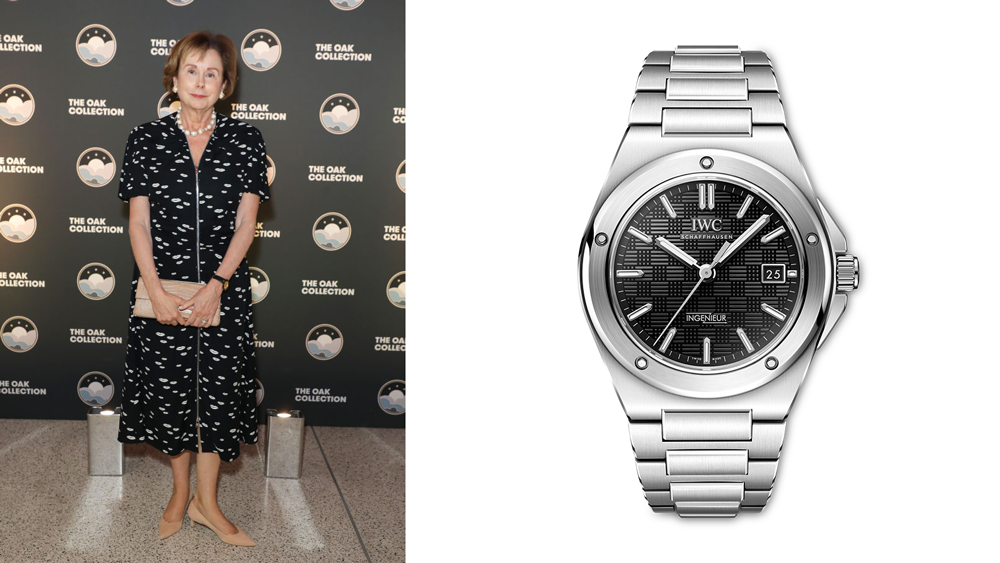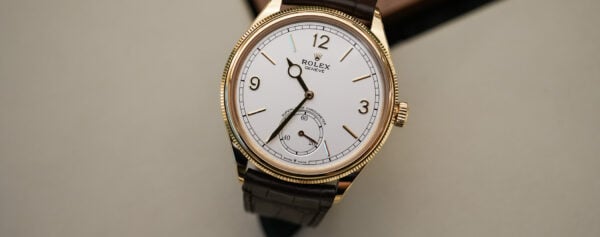 David M. Benett; IWC
David M. Benett; IWC
With the debut of the new Ingenieur Automatic 40 at Watches and Wonders Geneva, IWC Schaffhausen is shining the spotlight anew on the legacy of the late designer Gérald Genta, whose 1976 Ingenieur SL, Ref. 1832—together with the Audemars Piguet Royal Oak and the Patek Philippe Nautilus—helped define the prevailing timepiece style of, and since, the 1970s.
During a pre-Watches and Wonders event in London in late February, IWC invited Genta’s widow and business partner, Évelyne Genta, to shed light on her husband’s design approach, his experience with the Swiss-German brand and what he would make of the current hoopla over his timepieces. (This, of course, was before news broke that LVMH would revive the Gérald Genta brand.)
Dressed in an electric blue Alexander McQueen suit, Genta, a citizen of Monaco who lives in London and oversees the Paris-based Gerald Genta Heritage Association, gamely answered questions during the media roundtable. Below, we highlight a selection of her comments on everything from Gerald’s true passion to how he really felt about watches.
On the Creation of the Gerald Genta Heritage Association
“We realized we were getting endless requests about my husband’s life, what he designed,” Genta told Robb Report. “People were very knowledgeable. Young watch lovers were very aware of my husband’s contributions to the watch industry. Yes, he created iconic models but he created many models. He was always ahead of the industry.”
On the Association’s Three-Fold Mission
“One is to identify one to two young designers, give them a prize, some money,” Genta said. “Second, to remind people how diverse my husband was. We made so many things no one knows about. We made belts, we made eyeglasses. And third, to authenticate.
“If I showed you the 3,000 designs I have, they’re all made on the same paper, with the same signature,” she added. “So we could authenticate these designs as a true Gerald Genta piece.”
On Genta’s True Love
“He painted every day,” Genta said. “People don’t know he considered himself a painter first and a watchmaker after.”
On His Role Model
“His dream was to be Picasso,” Genta said. “I don’t think there was an exhibition anywhere in the world of Picasso we didn’t go to. He said he met him once very briefly when he was young and it was like seeing God for him.”
On His Design Method

“He would take a compass and do a circle, draw a line this way and a line that way,” she said. “And then he’d take a little paintbrush and paint the design straight away. There was not one attempt and a second attempt, it was painted straight away.”
On Being an Independent Watchmaker
“He wanted to do his own brand,” Genta said. “He realized in those days that brands were not so generous as to say who was the designer. He had a very good relationship with Seiko. We went to an exhibition in Japan. Had a collection of six watches. Mr. Hatori said, ‘Mr. Genta, you have to do your own brand.’ From that point onwards, he kept his best models for himself.”
On Today’s Marketplace
“He would have hated somebody who bought a watch to sell it back a day later,” Genta said. “He considered himself an artist and I’m sure he would have hated the speculative aspect. He wanted people to enjoy his watches, not just as a means to make 30 percent quickly.”
On the Apple Watch
“I think he would have seen it as a very clever tool,” she said. “He had nothing against modernity, he would have seen it as something useful, like a little phone on the wrist. He wouldn’t have seen it as competition to a watch. What he didn’t like was copies.”
On IWC

“He loved the brand,” Genta said. “For its seriousness. For the fact they allowed him to do his design the way he thought about it.”
Genta said the first words her husband used to describe the brand were Swiss German, “and for him that meant they were very correct, very focused.”
“Every time we went to the Basel fair, we always went to see IWC. He had a lot of respect for proper watchmaking, excellent manufacturing, excellent quality—Swiss German.”
On Designing Watches
“He was self-taught,” Genta said. “He said he designed watches because he was Swiss. If he’d been Italian, he would have designed cars. He didn’t particularly love watches.”
Genta said her husband didn’t play favorites with his watch creations. “He was somebody,” she said, “who never looked back: ‘I like the one I’m designing now, and even more the one I will design tomorrow.’”




